Annotated Bibliography Assignment: MGT502 Business Communication
VerifiedAdded on 2023/01/19
|11
|2561
|88
Homework Assignment
AI Summary
This assignment presents an annotated bibliography on business communication, comprising ten sources that delve into various facets of workplace dynamics. The sources cover a range of topics, including organizational ethics, generational differences in the workplace, authentic leadership, workplace bullying, the association between spirituality and business ethics, moral emotions in organizations, ethical leadership, ethical considerations, and the impact of bullying and cliques. Each annotation provides a concise summary of the source's key arguments, the author's background and intended audience, and the significance of the work. The bibliography aims to explore contemporary organizational and business issues by analyzing and synthesizing a range of resources. The sources include academic journal articles and books, offering diverse perspectives on the challenges and opportunities in business communication and ethical practices. The assignment adheres to academic standards, including proper referencing and a clear structure to facilitate understanding of the various concepts.

Running head: BUSINESS COMMUNICATION
Business Communication
Name of the Student
Name of the University
Author’s Note
Business Communication
Name of the Student
Name of the University
Author’s Note
Paraphrase This Document
Need a fresh take? Get an instant paraphrase of this document with our AI Paraphraser
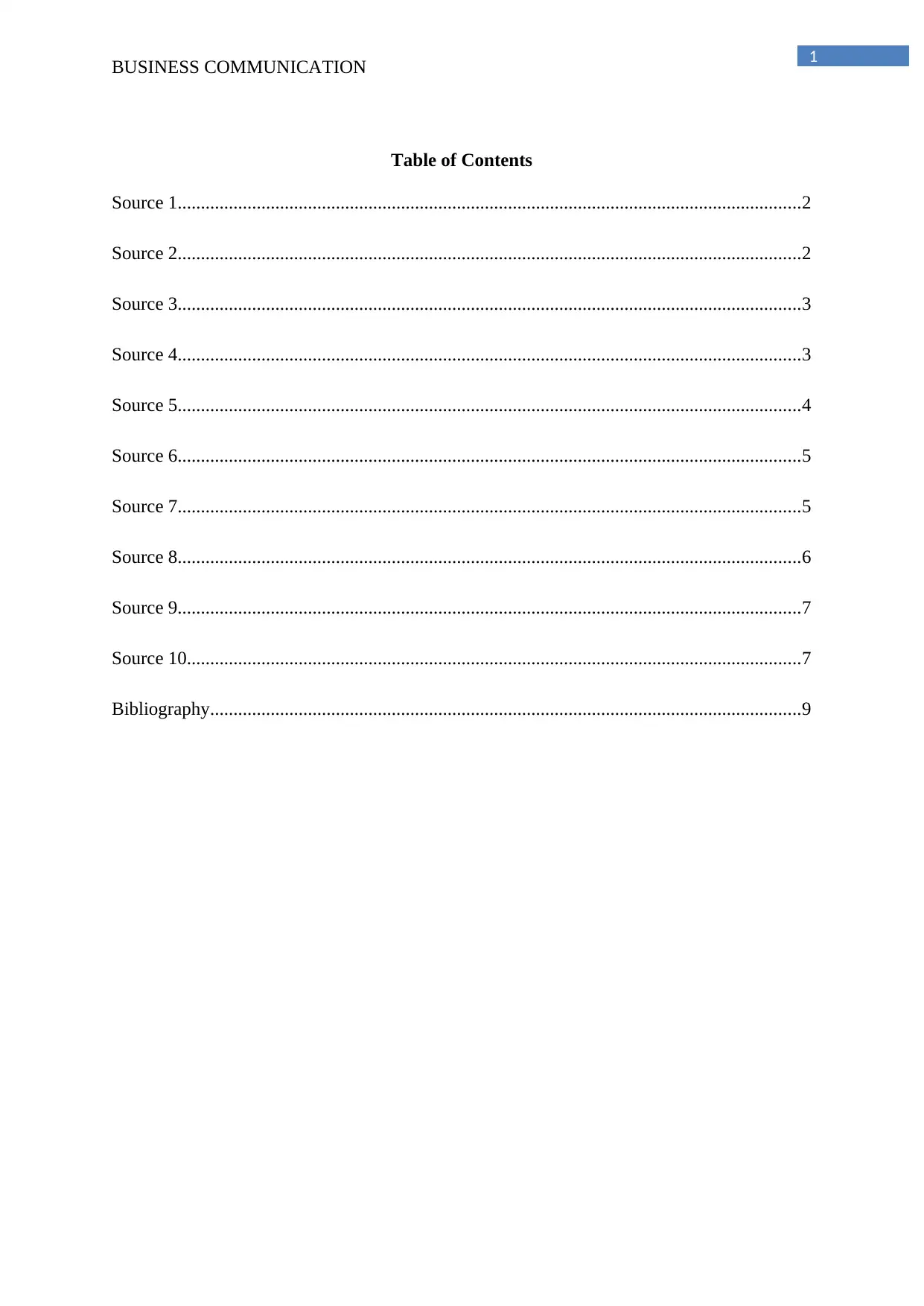
1
BUSINESS COMMUNICATION
Table of Contents
Source 1......................................................................................................................................2
Source 2......................................................................................................................................2
Source 3......................................................................................................................................3
Source 4......................................................................................................................................3
Source 5......................................................................................................................................4
Source 6......................................................................................................................................5
Source 7......................................................................................................................................5
Source 8......................................................................................................................................6
Source 9......................................................................................................................................7
Source 10....................................................................................................................................7
Bibliography...............................................................................................................................9
BUSINESS COMMUNICATION
Table of Contents
Source 1......................................................................................................................................2
Source 2......................................................................................................................................2
Source 3......................................................................................................................................3
Source 4......................................................................................................................................3
Source 5......................................................................................................................................4
Source 6......................................................................................................................................5
Source 7......................................................................................................................................5
Source 8......................................................................................................................................6
Source 9......................................................................................................................................7
Source 10....................................................................................................................................7
Bibliography...............................................................................................................................9

2
BUSINESS COMMUNICATION
Source 1
Ferrell, O. C. (2016). A framework for understanding organizational ethics. In Business
ethics: New challenges for business schools and corporate leaders (pp. 15-29). Routledge.
The author of the research is well known for his practices and research on workplace
ethics and the intended audience of the book written involves the organisational managers as
well as the business schools of Australia. Organisational ethics can be considered as an
important as well as a concept that is mostly overlooked or misunderstood. This particular
framework illuminates the bibliography topic as it denotes that the Australian organisations
need to be at par with the organisational ethics so that cultural dominance can take place
effectively. In most of the organisations in Australia, implementation of the organisational
ethics and initiatives have not been made thereby prevention of ethical and legal misconduct
can be deemed as challenging. At the same time, business schools have attempted to raise
awareness about workplace ethics by implementing courses that involve curricula with an
agreement about the things that need to be taught at business schools.
Source 2
Clark, K. R. (2017). Managing multiple generations in the workplace. Radiologic
technology, 88(4), 379-396.
In the modern generation, workplace consists of employees that belong to different
generations. Therefore, the ethical consideration as well as the cultural norms of each
generation are unique and are based on core values related to the policies of the organisations.
The author of the article can be credited with identifying the differences in generations so that
conflict between the employees can be avoided. The intended audiences of the article are the
hospital sectors mainly because the patients and the workers involved belong to different
BUSINESS COMMUNICATION
Source 1
Ferrell, O. C. (2016). A framework for understanding organizational ethics. In Business
ethics: New challenges for business schools and corporate leaders (pp. 15-29). Routledge.
The author of the research is well known for his practices and research on workplace
ethics and the intended audience of the book written involves the organisational managers as
well as the business schools of Australia. Organisational ethics can be considered as an
important as well as a concept that is mostly overlooked or misunderstood. This particular
framework illuminates the bibliography topic as it denotes that the Australian organisations
need to be at par with the organisational ethics so that cultural dominance can take place
effectively. In most of the organisations in Australia, implementation of the organisational
ethics and initiatives have not been made thereby prevention of ethical and legal misconduct
can be deemed as challenging. At the same time, business schools have attempted to raise
awareness about workplace ethics by implementing courses that involve curricula with an
agreement about the things that need to be taught at business schools.
Source 2
Clark, K. R. (2017). Managing multiple generations in the workplace. Radiologic
technology, 88(4), 379-396.
In the modern generation, workplace consists of employees that belong to different
generations. Therefore, the ethical consideration as well as the cultural norms of each
generation are unique and are based on core values related to the policies of the organisations.
The author of the article can be credited with identifying the differences in generations so that
conflict between the employees can be avoided. The intended audiences of the article are the
hospital sectors mainly because the patients and the workers involved belong to different
⊘ This is a preview!⊘
Do you want full access?
Subscribe today to unlock all pages.

Trusted by 1+ million students worldwide
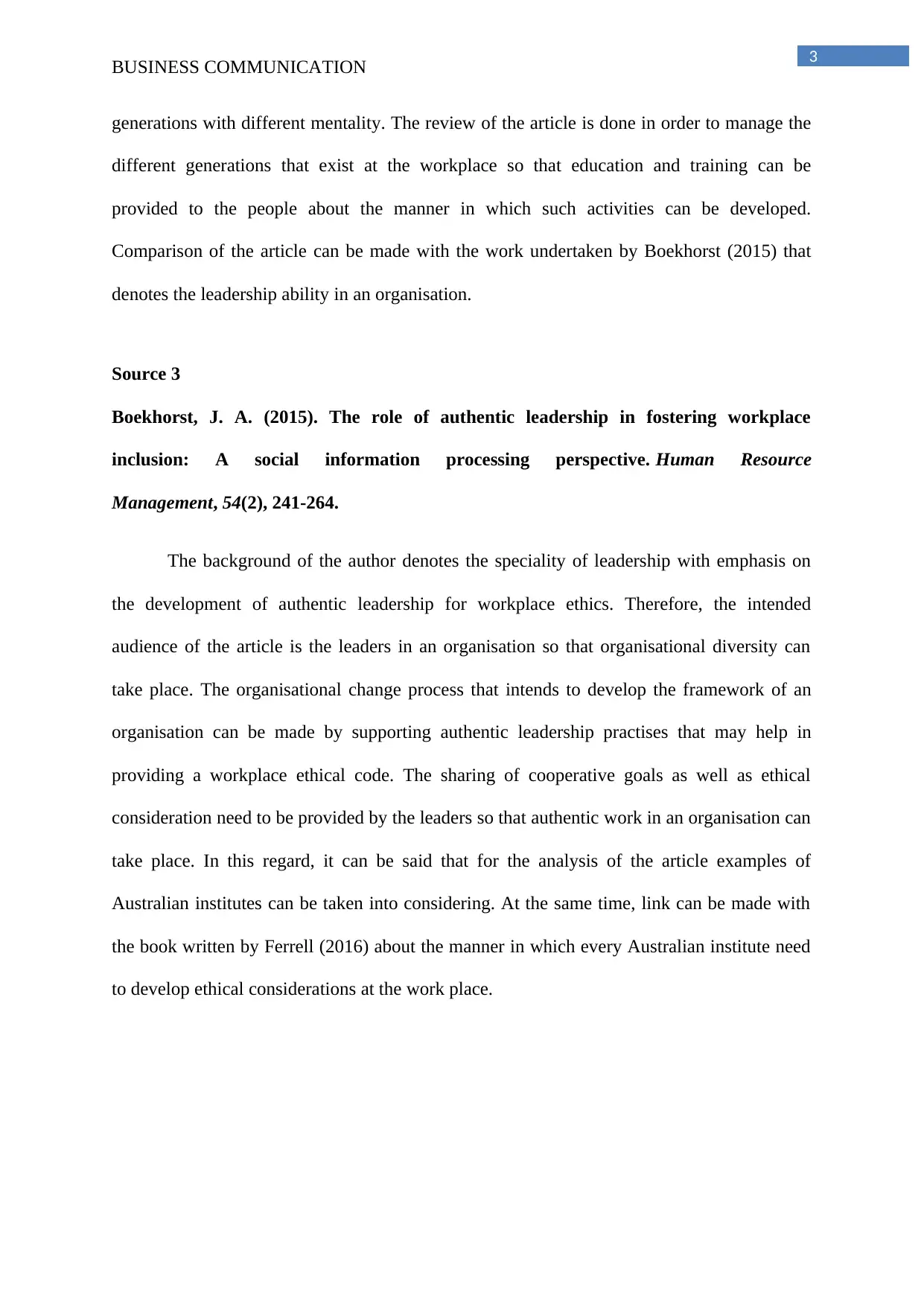
3
BUSINESS COMMUNICATION
generations with different mentality. The review of the article is done in order to manage the
different generations that exist at the workplace so that education and training can be
provided to the people about the manner in which such activities can be developed.
Comparison of the article can be made with the work undertaken by Boekhorst (2015) that
denotes the leadership ability in an organisation.
Source 3
Boekhorst, J. A. (2015). The role of authentic leadership in fostering workplace
inclusion: A social information processing perspective. Human Resource
Management, 54(2), 241-264.
The background of the author denotes the speciality of leadership with emphasis on
the development of authentic leadership for workplace ethics. Therefore, the intended
audience of the article is the leaders in an organisation so that organisational diversity can
take place. The organisational change process that intends to develop the framework of an
organisation can be made by supporting authentic leadership practises that may help in
providing a workplace ethical code. The sharing of cooperative goals as well as ethical
consideration need to be provided by the leaders so that authentic work in an organisation can
take place. In this regard, it can be said that for the analysis of the article examples of
Australian institutes can be taken into considering. At the same time, link can be made with
the book written by Ferrell (2016) about the manner in which every Australian institute need
to develop ethical considerations at the work place.
BUSINESS COMMUNICATION
generations with different mentality. The review of the article is done in order to manage the
different generations that exist at the workplace so that education and training can be
provided to the people about the manner in which such activities can be developed.
Comparison of the article can be made with the work undertaken by Boekhorst (2015) that
denotes the leadership ability in an organisation.
Source 3
Boekhorst, J. A. (2015). The role of authentic leadership in fostering workplace
inclusion: A social information processing perspective. Human Resource
Management, 54(2), 241-264.
The background of the author denotes the speciality of leadership with emphasis on
the development of authentic leadership for workplace ethics. Therefore, the intended
audience of the article is the leaders in an organisation so that organisational diversity can
take place. The organisational change process that intends to develop the framework of an
organisation can be made by supporting authentic leadership practises that may help in
providing a workplace ethical code. The sharing of cooperative goals as well as ethical
consideration need to be provided by the leaders so that authentic work in an organisation can
take place. In this regard, it can be said that for the analysis of the article examples of
Australian institutes can be taken into considering. At the same time, link can be made with
the book written by Ferrell (2016) about the manner in which every Australian institute need
to develop ethical considerations at the work place.
Paraphrase This Document
Need a fresh take? Get an instant paraphrase of this document with our AI Paraphraser

4
BUSINESS COMMUNICATION
Source 4
Valentine, S., Fleischman, G., & Godkin, L. (2015). Rogues in the ranks of selling
organizations: Using corporate ethics to manage workplace bullying and job
satisfaction. Journal of Personal Selling & Sales Management, 35(2), 143-163.
The authors focus on the manner in which workplace bullying can be prevented by
maintaining ethical codes of conduct. The focus is on the sales profession mainly because
these people are subjected to be having a negative impact based on deviant behaviour and
rationalisation. Therefore, it can be said that the background of the authors are sales
representatives and it is because of this that the intended audience of the article are the
organisations that are involved in selling services and products. This work can illuminate the
bibliography by stating the requirements of the sale person so that misbehaviour can be
reduced and an enhancement of the productivity of the organisations can take place. At the
same time, the assessment provides an overview of the consequences associated with
workplace bullying so that job satisfaction of the employees can improve. In this regard, it
can be said that a comparison can be made with the work of Boekhorst (2015) that denotes
the importance of leadership.
Source 5
Ayoun, B., Rowe, L., & Yassine, F. (2015). Is workplace spirituality associated with
business ethics?. International journal of Contemporary hospitality management, 27(5),
938-957.
The background of the author of the article is on management and business ethics.
The focus is on the hospitality sector mainly because ethics in the hotels and restaurants can
be considered as one of the main factors on which a hospitality industry can continue its
business. In this regard, it can be said that the target of the article is on the specific hotels in
BUSINESS COMMUNICATION
Source 4
Valentine, S., Fleischman, G., & Godkin, L. (2015). Rogues in the ranks of selling
organizations: Using corporate ethics to manage workplace bullying and job
satisfaction. Journal of Personal Selling & Sales Management, 35(2), 143-163.
The authors focus on the manner in which workplace bullying can be prevented by
maintaining ethical codes of conduct. The focus is on the sales profession mainly because
these people are subjected to be having a negative impact based on deviant behaviour and
rationalisation. Therefore, it can be said that the background of the authors are sales
representatives and it is because of this that the intended audience of the article are the
organisations that are involved in selling services and products. This work can illuminate the
bibliography by stating the requirements of the sale person so that misbehaviour can be
reduced and an enhancement of the productivity of the organisations can take place. At the
same time, the assessment provides an overview of the consequences associated with
workplace bullying so that job satisfaction of the employees can improve. In this regard, it
can be said that a comparison can be made with the work of Boekhorst (2015) that denotes
the importance of leadership.
Source 5
Ayoun, B., Rowe, L., & Yassine, F. (2015). Is workplace spirituality associated with
business ethics?. International journal of Contemporary hospitality management, 27(5),
938-957.
The background of the author of the article is on management and business ethics.
The focus is on the hospitality sector mainly because ethics in the hotels and restaurants can
be considered as one of the main factors on which a hospitality industry can continue its
business. In this regard, it can be said that the target of the article is on the specific hotels in
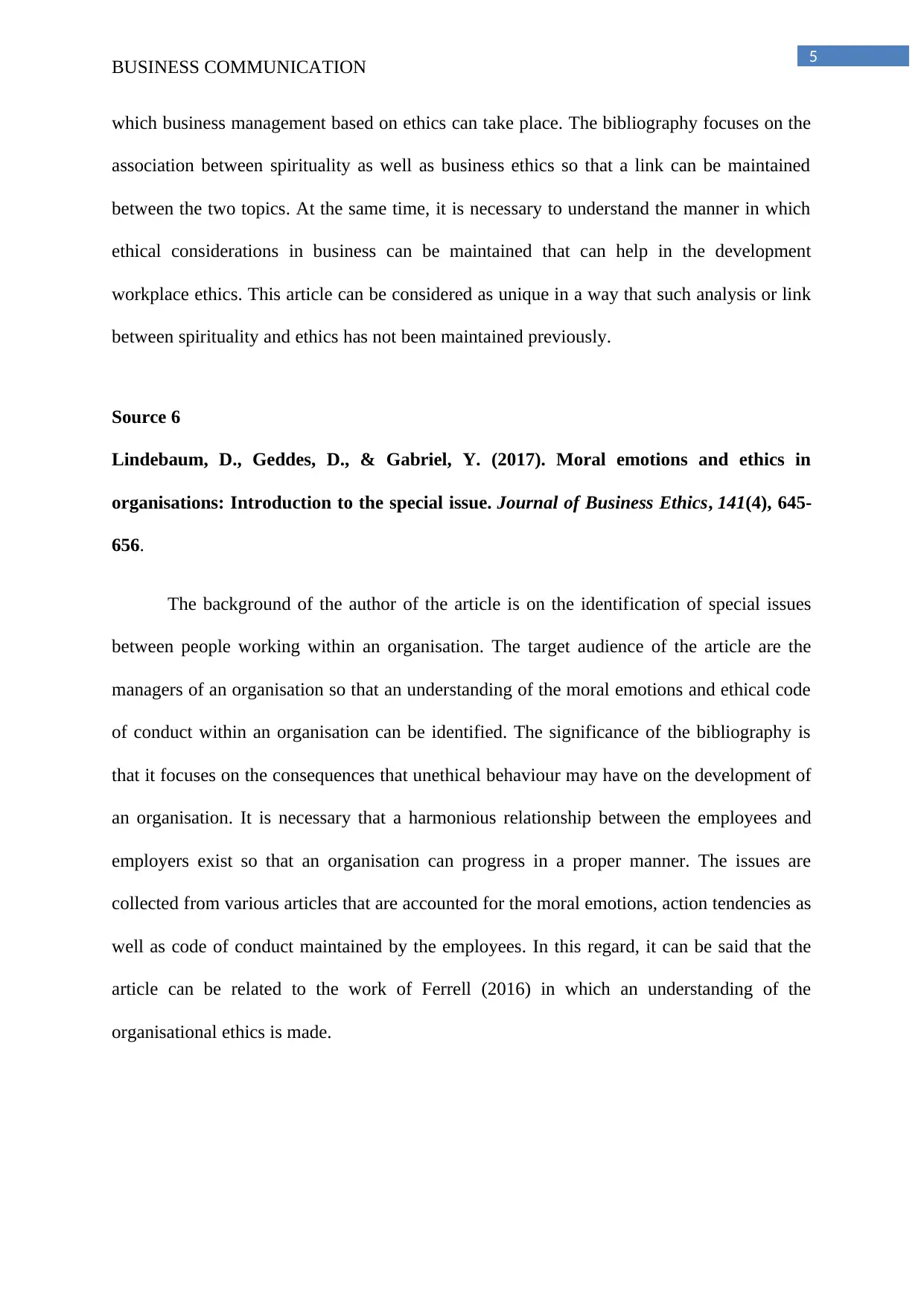
5
BUSINESS COMMUNICATION
which business management based on ethics can take place. The bibliography focuses on the
association between spirituality as well as business ethics so that a link can be maintained
between the two topics. At the same time, it is necessary to understand the manner in which
ethical considerations in business can be maintained that can help in the development
workplace ethics. This article can be considered as unique in a way that such analysis or link
between spirituality and ethics has not been maintained previously.
Source 6
Lindebaum, D., Geddes, D., & Gabriel, Y. (2017). Moral emotions and ethics in
organisations: Introduction to the special issue. Journal of Business Ethics, 141(4), 645-
656.
The background of the author of the article is on the identification of special issues
between people working within an organisation. The target audience of the article are the
managers of an organisation so that an understanding of the moral emotions and ethical code
of conduct within an organisation can be identified. The significance of the bibliography is
that it focuses on the consequences that unethical behaviour may have on the development of
an organisation. It is necessary that a harmonious relationship between the employees and
employers exist so that an organisation can progress in a proper manner. The issues are
collected from various articles that are accounted for the moral emotions, action tendencies as
well as code of conduct maintained by the employees. In this regard, it can be said that the
article can be related to the work of Ferrell (2016) in which an understanding of the
organisational ethics is made.
BUSINESS COMMUNICATION
which business management based on ethics can take place. The bibliography focuses on the
association between spirituality as well as business ethics so that a link can be maintained
between the two topics. At the same time, it is necessary to understand the manner in which
ethical considerations in business can be maintained that can help in the development
workplace ethics. This article can be considered as unique in a way that such analysis or link
between spirituality and ethics has not been maintained previously.
Source 6
Lindebaum, D., Geddes, D., & Gabriel, Y. (2017). Moral emotions and ethics in
organisations: Introduction to the special issue. Journal of Business Ethics, 141(4), 645-
656.
The background of the author of the article is on the identification of special issues
between people working within an organisation. The target audience of the article are the
managers of an organisation so that an understanding of the moral emotions and ethical code
of conduct within an organisation can be identified. The significance of the bibliography is
that it focuses on the consequences that unethical behaviour may have on the development of
an organisation. It is necessary that a harmonious relationship between the employees and
employers exist so that an organisation can progress in a proper manner. The issues are
collected from various articles that are accounted for the moral emotions, action tendencies as
well as code of conduct maintained by the employees. In this regard, it can be said that the
article can be related to the work of Ferrell (2016) in which an understanding of the
organisational ethics is made.
⊘ This is a preview!⊘
Do you want full access?
Subscribe today to unlock all pages.

Trusted by 1+ million students worldwide
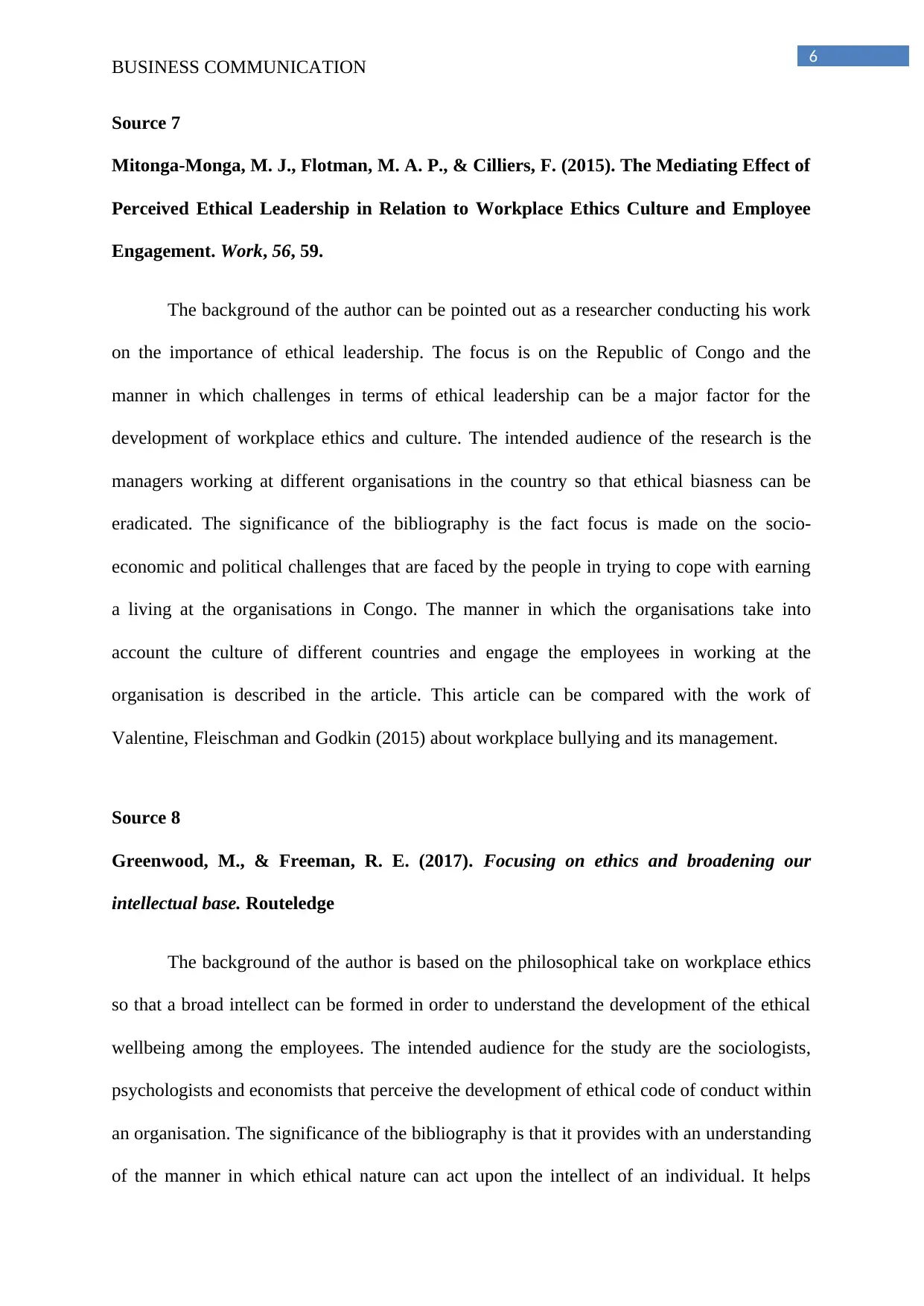
6
BUSINESS COMMUNICATION
Source 7
Mitonga-Monga, M. J., Flotman, M. A. P., & Cilliers, F. (2015). The Mediating Effect of
Perceived Ethical Leadership in Relation to Workplace Ethics Culture and Employee
Engagement. Work, 56, 59.
The background of the author can be pointed out as a researcher conducting his work
on the importance of ethical leadership. The focus is on the Republic of Congo and the
manner in which challenges in terms of ethical leadership can be a major factor for the
development of workplace ethics and culture. The intended audience of the research is the
managers working at different organisations in the country so that ethical biasness can be
eradicated. The significance of the bibliography is the fact focus is made on the socio-
economic and political challenges that are faced by the people in trying to cope with earning
a living at the organisations in Congo. The manner in which the organisations take into
account the culture of different countries and engage the employees in working at the
organisation is described in the article. This article can be compared with the work of
Valentine, Fleischman and Godkin (2015) about workplace bullying and its management.
Source 8
Greenwood, M., & Freeman, R. E. (2017). Focusing on ethics and broadening our
intellectual base. Routeledge
The background of the author is based on the philosophical take on workplace ethics
so that a broad intellect can be formed in order to understand the development of the ethical
wellbeing among the employees. The intended audience for the study are the sociologists,
psychologists and economists that perceive the development of ethical code of conduct within
an organisation. The significance of the bibliography is that it provides with an understanding
of the manner in which ethical nature can act upon the intellect of an individual. It helps
BUSINESS COMMUNICATION
Source 7
Mitonga-Monga, M. J., Flotman, M. A. P., & Cilliers, F. (2015). The Mediating Effect of
Perceived Ethical Leadership in Relation to Workplace Ethics Culture and Employee
Engagement. Work, 56, 59.
The background of the author can be pointed out as a researcher conducting his work
on the importance of ethical leadership. The focus is on the Republic of Congo and the
manner in which challenges in terms of ethical leadership can be a major factor for the
development of workplace ethics and culture. The intended audience of the research is the
managers working at different organisations in the country so that ethical biasness can be
eradicated. The significance of the bibliography is the fact focus is made on the socio-
economic and political challenges that are faced by the people in trying to cope with earning
a living at the organisations in Congo. The manner in which the organisations take into
account the culture of different countries and engage the employees in working at the
organisation is described in the article. This article can be compared with the work of
Valentine, Fleischman and Godkin (2015) about workplace bullying and its management.
Source 8
Greenwood, M., & Freeman, R. E. (2017). Focusing on ethics and broadening our
intellectual base. Routeledge
The background of the author is based on the philosophical take on workplace ethics
so that a broad intellect can be formed in order to understand the development of the ethical
wellbeing among the employees. The intended audience for the study are the sociologists,
psychologists and economists that perceive the development of ethical code of conduct within
an organisation. The significance of the bibliography is that it provides with an understanding
of the manner in which ethical nature can act upon the intellect of an individual. It helps
Paraphrase This Document
Need a fresh take? Get an instant paraphrase of this document with our AI Paraphraser
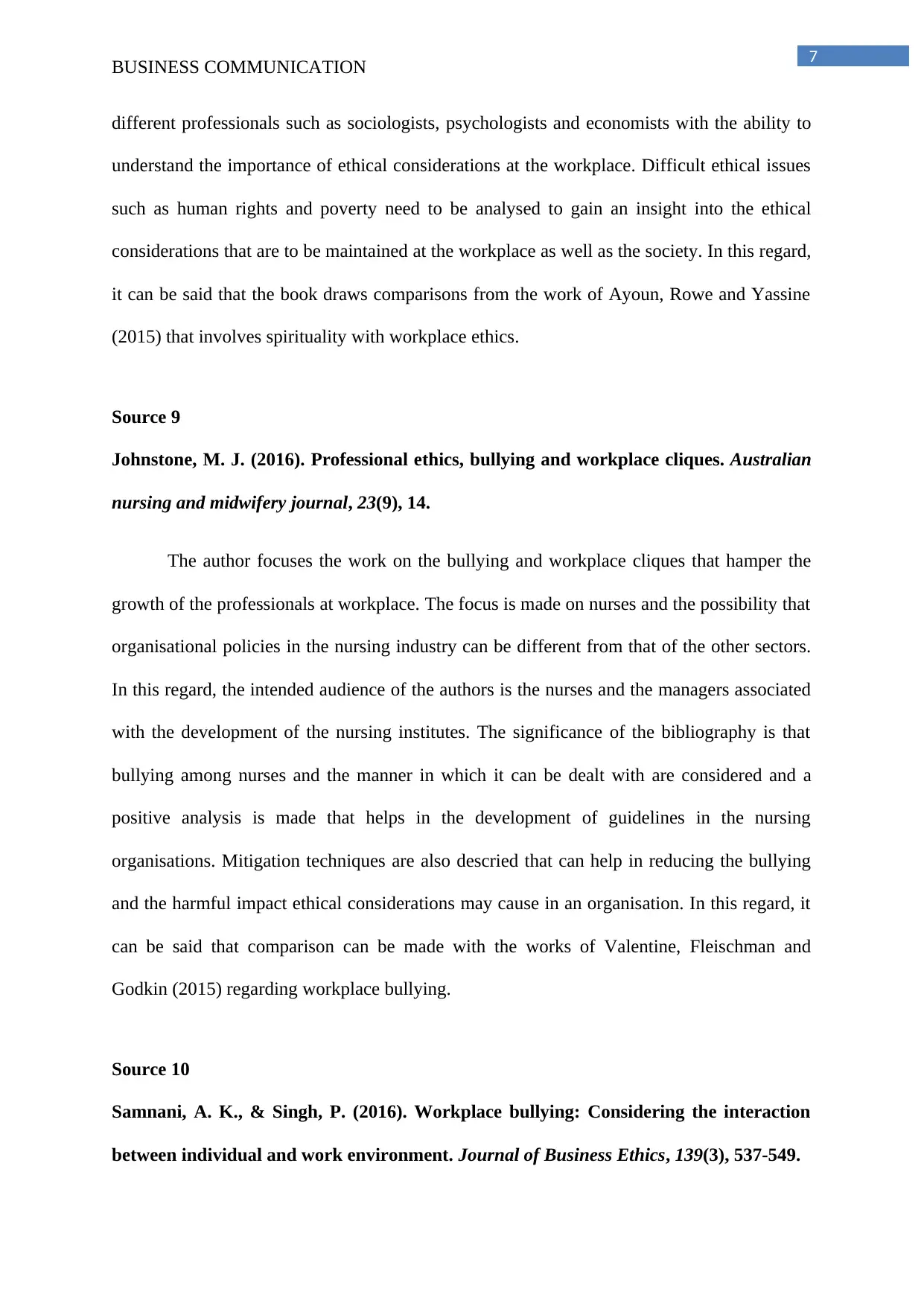
7
BUSINESS COMMUNICATION
different professionals such as sociologists, psychologists and economists with the ability to
understand the importance of ethical considerations at the workplace. Difficult ethical issues
such as human rights and poverty need to be analysed to gain an insight into the ethical
considerations that are to be maintained at the workplace as well as the society. In this regard,
it can be said that the book draws comparisons from the work of Ayoun, Rowe and Yassine
(2015) that involves spirituality with workplace ethics.
Source 9
Johnstone, M. J. (2016). Professional ethics, bullying and workplace cliques. Australian
nursing and midwifery journal, 23(9), 14.
The author focuses the work on the bullying and workplace cliques that hamper the
growth of the professionals at workplace. The focus is made on nurses and the possibility that
organisational policies in the nursing industry can be different from that of the other sectors.
In this regard, the intended audience of the authors is the nurses and the managers associated
with the development of the nursing institutes. The significance of the bibliography is that
bullying among nurses and the manner in which it can be dealt with are considered and a
positive analysis is made that helps in the development of guidelines in the nursing
organisations. Mitigation techniques are also descried that can help in reducing the bullying
and the harmful impact ethical considerations may cause in an organisation. In this regard, it
can be said that comparison can be made with the works of Valentine, Fleischman and
Godkin (2015) regarding workplace bullying.
Source 10
Samnani, A. K., & Singh, P. (2016). Workplace bullying: Considering the interaction
between individual and work environment. Journal of Business Ethics, 139(3), 537-549.
BUSINESS COMMUNICATION
different professionals such as sociologists, psychologists and economists with the ability to
understand the importance of ethical considerations at the workplace. Difficult ethical issues
such as human rights and poverty need to be analysed to gain an insight into the ethical
considerations that are to be maintained at the workplace as well as the society. In this regard,
it can be said that the book draws comparisons from the work of Ayoun, Rowe and Yassine
(2015) that involves spirituality with workplace ethics.
Source 9
Johnstone, M. J. (2016). Professional ethics, bullying and workplace cliques. Australian
nursing and midwifery journal, 23(9), 14.
The author focuses the work on the bullying and workplace cliques that hamper the
growth of the professionals at workplace. The focus is made on nurses and the possibility that
organisational policies in the nursing industry can be different from that of the other sectors.
In this regard, the intended audience of the authors is the nurses and the managers associated
with the development of the nursing institutes. The significance of the bibliography is that
bullying among nurses and the manner in which it can be dealt with are considered and a
positive analysis is made that helps in the development of guidelines in the nursing
organisations. Mitigation techniques are also descried that can help in reducing the bullying
and the harmful impact ethical considerations may cause in an organisation. In this regard, it
can be said that comparison can be made with the works of Valentine, Fleischman and
Godkin (2015) regarding workplace bullying.
Source 10
Samnani, A. K., & Singh, P. (2016). Workplace bullying: Considering the interaction
between individual and work environment. Journal of Business Ethics, 139(3), 537-549.
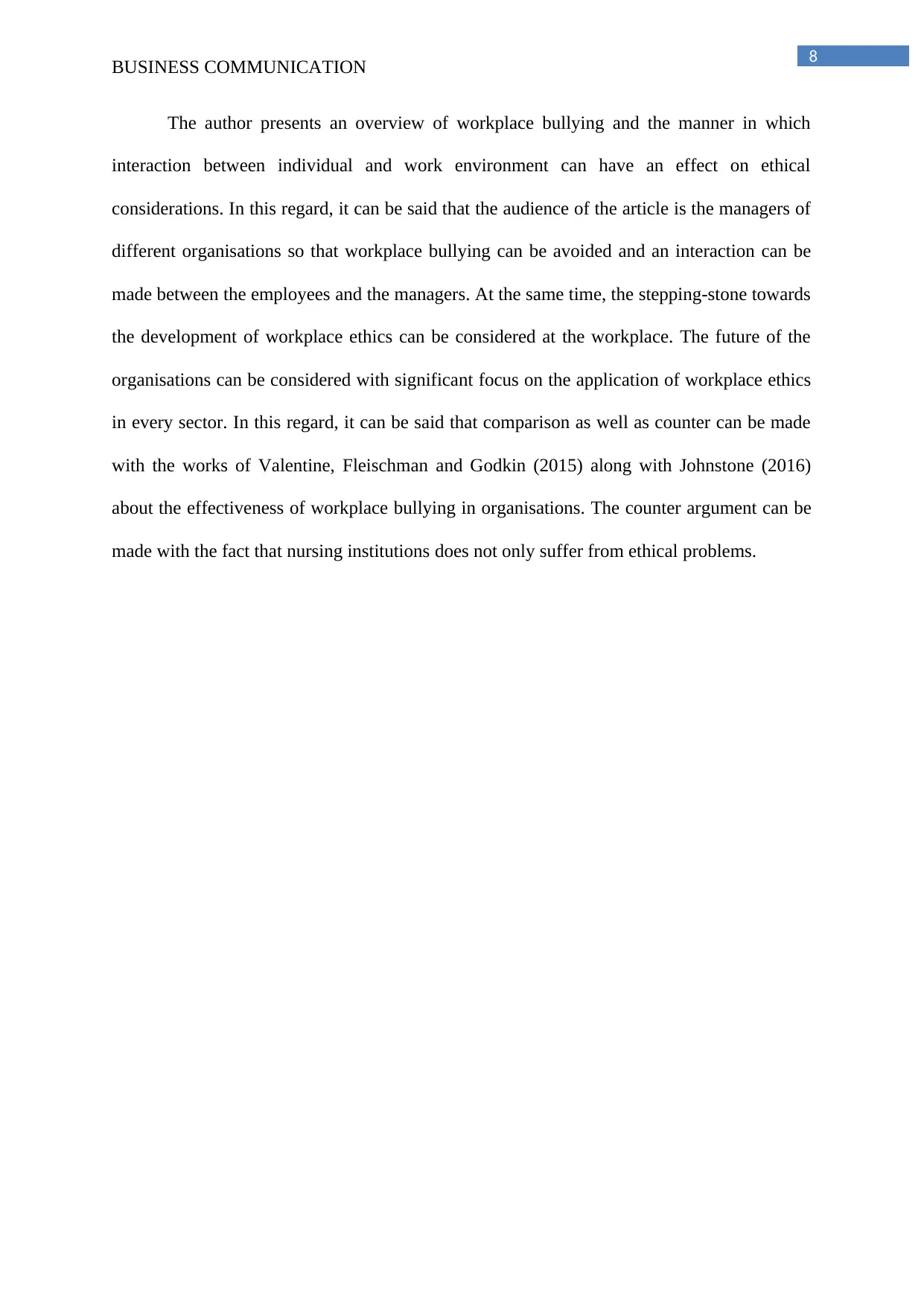
8
BUSINESS COMMUNICATION
The author presents an overview of workplace bullying and the manner in which
interaction between individual and work environment can have an effect on ethical
considerations. In this regard, it can be said that the audience of the article is the managers of
different organisations so that workplace bullying can be avoided and an interaction can be
made between the employees and the managers. At the same time, the stepping-stone towards
the development of workplace ethics can be considered at the workplace. The future of the
organisations can be considered with significant focus on the application of workplace ethics
in every sector. In this regard, it can be said that comparison as well as counter can be made
with the works of Valentine, Fleischman and Godkin (2015) along with Johnstone (2016)
about the effectiveness of workplace bullying in organisations. The counter argument can be
made with the fact that nursing institutions does not only suffer from ethical problems.
BUSINESS COMMUNICATION
The author presents an overview of workplace bullying and the manner in which
interaction between individual and work environment can have an effect on ethical
considerations. In this regard, it can be said that the audience of the article is the managers of
different organisations so that workplace bullying can be avoided and an interaction can be
made between the employees and the managers. At the same time, the stepping-stone towards
the development of workplace ethics can be considered at the workplace. The future of the
organisations can be considered with significant focus on the application of workplace ethics
in every sector. In this regard, it can be said that comparison as well as counter can be made
with the works of Valentine, Fleischman and Godkin (2015) along with Johnstone (2016)
about the effectiveness of workplace bullying in organisations. The counter argument can be
made with the fact that nursing institutions does not only suffer from ethical problems.
⊘ This is a preview!⊘
Do you want full access?
Subscribe today to unlock all pages.

Trusted by 1+ million students worldwide

9
BUSINESS COMMUNICATION
Bibliography
Ayoun, B., Rowe, L., & Yassine, F. (2015). Is workplace spirituality associated with business
ethics?. International journal of Contemporary hospitality management, 27(5), 938-
957.
Boddy, C., & Taplin, R. (2017). A note on workplace psychopathic bullying–Measuring its
frequency and severity. Aggression and violent behavior, 34, 117-119.
Boekhorst, J. A. (2015). The role of authentic leadership in fostering workplace inclusion: A
social information processing perspective. Human Resource Management, 54(2), 241-
264.
Clark, K. R. (2017). Managing multiple generations in the workplace. Radiologic
technology, 88(4), 379-396.
Ferrell, O. C. (2016). A framework for understanding organizational ethics. In Business
ethics: New challenges for business schools and corporate leaders (pp. 15-29).
Routledge.
Greenwood, M., & Freeman, R. E. (2017). Focusing on ethics and broadening our
intellectual base. Routeledge
Johnstone, M. J. (2016). Professional ethics, bullying and workplace cliques. Australian
nursing and midwifery journal, 23(9), 14.
Lindebaum, D., Geddes, D., & Gabriel, Y. (2017). Moral emotions and ethics in
organisations: Introduction to the special issue. Journal of Business Ethics, 141(4),
645-656.
BUSINESS COMMUNICATION
Bibliography
Ayoun, B., Rowe, L., & Yassine, F. (2015). Is workplace spirituality associated with business
ethics?. International journal of Contemporary hospitality management, 27(5), 938-
957.
Boddy, C., & Taplin, R. (2017). A note on workplace psychopathic bullying–Measuring its
frequency and severity. Aggression and violent behavior, 34, 117-119.
Boekhorst, J. A. (2015). The role of authentic leadership in fostering workplace inclusion: A
social information processing perspective. Human Resource Management, 54(2), 241-
264.
Clark, K. R. (2017). Managing multiple generations in the workplace. Radiologic
technology, 88(4), 379-396.
Ferrell, O. C. (2016). A framework for understanding organizational ethics. In Business
ethics: New challenges for business schools and corporate leaders (pp. 15-29).
Routledge.
Greenwood, M., & Freeman, R. E. (2017). Focusing on ethics and broadening our
intellectual base. Routeledge
Johnstone, M. J. (2016). Professional ethics, bullying and workplace cliques. Australian
nursing and midwifery journal, 23(9), 14.
Lindebaum, D., Geddes, D., & Gabriel, Y. (2017). Moral emotions and ethics in
organisations: Introduction to the special issue. Journal of Business Ethics, 141(4),
645-656.
Paraphrase This Document
Need a fresh take? Get an instant paraphrase of this document with our AI Paraphraser

10
BUSINESS COMMUNICATION
Mitonga-Monga, M. J., Flotman, M. A. P., & Cilliers, F. (2015). The Mediating Effect of
Perceived Ethical Leadership in Relation to Workplace Ethics Culture and Employee
Engagement. Work, 56, 59.
Samnani, A. K., & Singh, P. (2016). Workplace bullying: Considering the interaction
between individual and work environment. Journal of Business Ethics, 139(3), 537-
549.
Sullivan, D. (2015). Is There Such a Thing as Business Ethics? Applying and Reinterpreting
MacIntyre's Virtue Ethics in the Modern Workplace.
Valentine, S., Fleischman, G., & Godkin, L. (2015). Rogues in the ranks of selling
organizations: Using corporate ethics to manage workplace bullying and job
satisfaction. Journal of Personal Selling & Sales Management, 35(2), 143-163.
BUSINESS COMMUNICATION
Mitonga-Monga, M. J., Flotman, M. A. P., & Cilliers, F. (2015). The Mediating Effect of
Perceived Ethical Leadership in Relation to Workplace Ethics Culture and Employee
Engagement. Work, 56, 59.
Samnani, A. K., & Singh, P. (2016). Workplace bullying: Considering the interaction
between individual and work environment. Journal of Business Ethics, 139(3), 537-
549.
Sullivan, D. (2015). Is There Such a Thing as Business Ethics? Applying and Reinterpreting
MacIntyre's Virtue Ethics in the Modern Workplace.
Valentine, S., Fleischman, G., & Godkin, L. (2015). Rogues in the ranks of selling
organizations: Using corporate ethics to manage workplace bullying and job
satisfaction. Journal of Personal Selling & Sales Management, 35(2), 143-163.
1 out of 11
Related Documents
Your All-in-One AI-Powered Toolkit for Academic Success.
+13062052269
info@desklib.com
Available 24*7 on WhatsApp / Email
![[object Object]](/_next/static/media/star-bottom.7253800d.svg)
Unlock your academic potential
Copyright © 2020–2025 A2Z Services. All Rights Reserved. Developed and managed by ZUCOL.





